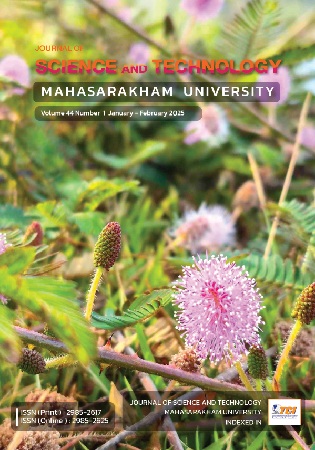Prediction of soil health for plants using deep neural networks
Main Article Content
Abstract
The objective of this research is to create a soil health prediction model at present by simulating the environmental conditions for growing yellow beans in four different environments. These environments involve three pots each, representing the following conditions: environment 1: watering and chemical fertilizer application, environment 2: watering and organic fertilizer application, environment 3: watering only, and environment 4: no watering or fertilization. Additionally, an Internet of Things (IoT) system was developed to collect soil health data over 2 months, resulting in a total of 475 data points. The collected data was then grouped to assign the most suitable number of clusters using the K-means algorithm. This process yielded three clusters that best fit the soil health data, each corresponding to different levels of soil health: Suitable, Moderate, and Improvement. Labels were assigned to each data point within the clusters, indicating the corresponding soil health level. Subsequently, the data was utilized to create a soil health prediction model using deep-learning neural network algorithms. Through experimentation, the model achieved 98% accuracy in predicting soil health.
Article Details
References
กรมวุฒิ นงนุช. (2561). ระบบสั่งงานด้วยเสียงบนเทคโนโลยีสรรพสิ่งเพื่อประยุกต์ควบคุมมอเตอร์ในงานด้านเกษตรกรรม. มหาวิทยาลัยเทคโนโลยีราชมงคลสุวรรณภูมิ
ชนิดา ยุบลไสย์, วิศวะ กุลนะ, & คมกฤษณ์ ชูเรือง. (2022). ระบบการวัดและบันทึกค่า pH ของดิน โดยใช้ Internet of Things (IoT). วารสารวิจัย และพัฒนาอนุภูมิภาคลุ่มน้ำโขง, 1(1), 1-7.
ธวัชชัย พรหมรัตน์ และ ดุษฎี คําบุญเรือง. (2566). การจัดกลุ่มข้อมูลคุณภาพดินที่ได้จากการปลูกต้นถั่วเหลืองโดยใช้เทคนิคการเรียนรู้ของเครื่อง. รายงานสืบเนื่องจากการประชุมวิชาการระดับชาติ “ราชภัฏกรุงเก่า” ครั้งที่ 6 (2023 6th EEAAT & ARU CON.) ภาคบรรยาย (Oral Presentation) วันที่ 21 – 22 ธันวาคม พ.ศ. 2566 ณ มหาวิทยาลัยราชภัฏพระนครศรีอยุธยา, 751 – 758. https://www.aru.ac.th/arucon/2023/EEAAT-ARUCON2023Oral-roceedingsV1.pdf
ประจวบ เพิ่มสุวรรณ และ มณฑล นุ่นละออง. (2013). ปัจจัยที่มีผลต่อการยอมรับระบบคลาวด์คอมพิวติ้งของผู้ ที่งานด้านเทคโนโลยีสารสนเทศ. Rajabhat Chiang Mai Research Journal, 14(2), 47-60.
ภาณุ เดชทิพย์อักษร, อรรถพล วิเวก, & อนุพงศ์ ไพโรจน์. (2022). การประยุกต์ใช้งานแอปพลิ เคชั่นปัญญาประดิษฐ์ร่วมกับอินเทอร์เน็ตของ สรรพสิ่งบนคลาวด์ในอาคารอัจฉริยะ. วารสาร วิศวกรรมศาสตร์มหาวิทยาลัยเทคโนโลยีราช มงคลล้านนา, 7(1), 52-61.
วิทยา ปัญญา และวฤษาย์ ร่มสายหยุด. (2023). วิธีการสร้างแบบจำลองเชิงทำนายพฤติกรรมการผิด เงื่อนไขการปล่อยชั่วคราวของศาลจากชุดข้อมูลที่ไม่ สมดุลโดยใช้เทคนิคการเรียนรู้ของเครื่อง. วารสารวิทยาศาสตร์และเทคโนโลยี มหาวิทยาลัยมหาสารคาม, 42(2), 7-17.
สุภาวดี หนูสิน. (2021). ผลกระทบจากการใช้ปุ๋ยเคมี ทางการเกษตร. วารสารบริหารการพัฒนา นวัตกรรมเชิงบูรณาการ, 1(2), 34 - 43.
โยธิน เกตุเมฆ และ ธวัชชัย พรหมรัตน์. (2567). การตรวจสอบและรายงานคุณภาพดินของพืชโดยใช้อินเทอร์เน็ตของสรรพสิ่ง.รายงานสืบเนื่องจากการประชุมวิชาการระดับปริญญาตรีด้านคอมพิวเตอร์ภูมิภาคเอเชียครั้งที่ 12 (Oral Conference Proceeding) วันที่ 21-23 กุมภาพันธ์ 2567 ณ คณะวิทยาการสารสนเทศ มหาวิทยาลัยมหาสารคาม, 400-408.
Allenbrand, C. (2024). Supervised and unsupervised learning models for pharmaceutical drug rating and classification using consumer generated reviews. Healthcare Analytics, 5, 100288.
Chandrashekar, G., & Sahin, F. (2014). A survey on feature selection methods. Computers & Electrical Engineering, 40(1), 16-28.
Ezugwu, A. E., Ikotun, A. M., Oyelade, O. O., Abualigah, L., Agushaka, J. O., Eke, C. I., & Akinyelu, A. A. (2022). A comprehensive survey of clustering algorithms: State-of-the-art machine learning applications, taxonomy, challenges, and future research prospects. Engineering Applications of Artificial Intelligence, 110, 104743.
Hamena, S., & Meshoul, S. (2018, October). Deep neural network for classification and prediction of oxygen binding proteins. Proceedings of the 2018 2nd International Conference on Computational Biology and Bioinformatics, 72-77.
Hanifi, S., Cammarono, A., & Zare-Behtash, H. (2024). Advanced hyperparameter optimization of deep learning models for wind power prediction. Renewable Energy, 221, 119700.
Li, J., Ma, R., Deng, M., Cao, X., Wang, X., & Wang, X. (2024). A comparative study of clustering algorithms for intermittent heating demand considering time series. Applied Energy, 353, 122046.
Liu, W., Wang, Z., Liu, X., Zeng, N., Liu, Y., & Alsaadi, F. E. (2017). A survey of deep neural network architectures and their applications. Neurocomputing, 234, 11-26.
Phyo, P. P., & Jeenanunta, C. (2019). Electricity load forecasting using a deep neural network. Engineering and Applied Science Research, 46(1), 10-17.
Pongpaibool, P., Niruntasukrat, A., & Meesublak, K. (2020). แพลตฟอร์มอินเทอร์เน็ตของสรรพสิ่ง ฐานรากสำคัญสู่การสร้างสรรค์นวัตกรรม ดิจิทัล. NBTC Journal, 4(4), 269-287.
Rattanapoka, C., Jannet, P., & Moonpanyo, T. (2022). ระบบบริการการจำแนกเพศและประเมินอายุ บุคคลจากภาพใบหน้าด้วยวิธีการเรียนรู้เชิงลึก. The Journal of Industrial Technology, 18(2), 164-179. https://ojs.kmutnb.ac.th/index.php/joindtech/article/view/5820
Sukreep, S., Mongkolnam, P., & Nukoolkit, C. (2015). Detect the daily activities and in-house locations using smartphone. In Recent Advances in Information and Communication Technology 2015. Proceedings of the 11th International Conference on Computing and Information Technology (IC2IT). Springer International Publishing, 215-225.
https://link.springer.com/chapter/10.1007/978-3-319-19024-2_22.
Wang, J., Chang, L., Aggarwal, S., Abari, O., & Keshav, S. (2020, June). Soil moisture sensing with commodity RFID systems. In Proceedings of the 18th International Conference on Mobile Systems, applications, and Services, 273-285. https://web.cs.ucla.edu/~omid/Papers/Mobisys20.pdf.

